Thunderbolt VII – “Easy 8″
Tank Veteran Recalls Yule Dash to Bastogne
By Dick Habein
Published in Stars and Stripes, December 27, 1949
Nazi propagandists used to say that before a man could join the 4th Armd Div he had to be nameless and guilty of matricide. If the average German soldier didn't believe that story after Christmas 1944, the chances are he hadn't been in the Bastogne area.
In the middle of December 1944, the 37th Tank Bn, 4th Armd Div, commanded by Lt Col Creighton W. Abrams, was attached to the 87th Inf Div and engaged in "feeler" operations along the Siegfried Line on the border of Lorraine. Plans were being made to withdraw the battalion for reinforcements and new equipment, because heavy fighting had dropped its tank strength to company level. Then there was the "fire call."
The Von Rundstedt offensive had started in the Ardennes and although Abrams, who now commands the 63d Hv Tank Bn, 1st Inf Div, stationed at Mannheim, and his men did not know it at the time, they were going to race 100 miles north, punch through the German ring of iron around Bastogne and be the first unit to reach U.S. Forces there.
And so the armored trek from Lorraine began. Days were overcast and at night weary tankers stared at blackout lights ahead. But in two days, units of the 4th had made contact with the south flank of the 40-mile German penetration.
The 4th assembled at Arlon. Units on the average took only 19 hours to cover 120 miles. Bastogne lay ahead — north along the highway from Neufchateau.
Abrams and his men joined the 53d Armd Inf Bn, commanded by. Lt Col George (Jiggers) Jacques, in combat reserve and held the 4th's right flank for a time.
"The Germans had overrun and cut up many American units," Abrams says. "We had orders to pick up the remnants and bring them into our outfit. We found some Americans and we found some Germans. We had to be careful not to shoot the wrong men."
"We picked up some badly needed American tanks, too, that the Germans had captured, and were using. We didn't have to shoot them up much, so they were all right," the stocky, 35-year-old West Point graduate says.
On Christmas Eve, Abrams' unit and the 53d Armd Inf were ordered to swing to the left flank of the 4th to handle German units which had penetrated west of Bastogne.
The day before Christmas was clear, and the 3d Army drive to break through to Bastogne was three days old. Out of that. clear sky came the Air Force and the RAF to raise all the hell with Jerry that they could. They raised plenty.
Seven. bomber groups and one division of the 8th Air Force and elements of the RAF took to the air to support the 3d Army.
Over Bigonville, held by elements of the German 5th Paratroop Div, roared the Thunderbolts, bombing scant yards ahead of advancing U.S. tanks.
"Let 'er roll," Colonel "Abe" told his men. He moved ahead in his tank, Thunderbolt VII. "Betty," "Deuces Wild," "Destruction" and the others followed. They fought for Bigonville. The enemy wanted the town bad and, as one sergeant said, "the krauts were young and mean."
The town exchanged hands three times before the Germans said goodby to it forever. They used U.S. equipment, including a Sherman tank, and left behind 350 dead and 300 prisoners.
At 2 am on Christmas morning, Abrams' unit and the 53d moved west, marching 30 miles to Bercheaux. By 7 am, they were ready to launch a surprise attack.
The AF came over again, this time with P47s.
"We've got everything here," Abrams told a war correspondent. "You want the Air Force —- give them a ring. We've got artillery so thick a German louse couldn't crawl through it."
Abrams and Jacques moved on. They followed a narrow, rutted road. As he rolled along, "Abe" chewed on a long, unlit cigar.
"It looked like another gun," his men told Will Lang of Life magazine.
He was bent on destruction. "Overpowering violence;" he told a correspondent, "to save American lives."
The next day, Dec. 26, Abrams' unit was poised on a knoll overlooking the road leading to Clochimont and Assenois. A few miles beyond, men of the 101st Abn Div were crouched in foxholes in a snow-covered field.
"Abe" looked out from his turret. "We're going to get to those people," he said. Then he motioned with his arm and the tank column snaked down the hill to Clochimont.
First Lt Charles Boggess, tanker in Abrams' battalion, described the action this way:
"The Germans had these two little towns of Clochimont and Assenois on the secondary road we were using to get to Bastogne. Beyond Assenois, the road ran up a ridge through heavy woods. There were a lot of Germans there, too.
"We were going through fast, all guns firing, straight up that road to bust through before they had time to get set."
Abrams' tanks galloped through Clochimont. A German 88 shell ploughed into a half-track, killing an infantryman. A telephone pole dropped on a Sherman and "Abe" and his men had to crawl out of their tanks, as snipers potted at them, and drag the pole away. Infantrymen of the 53d stayed behind and mopped up. The tanks moved on for Assenois.
Pvt James R. Hendrix, Congressional Medal of Honor winner, went into Assenois with a company of the 53d.
He said: "We ran up yelling 'come out,' but they wouldn't. One poked his head out of a foxhole and I shot him through the neck. I got closer and hit another on the head with the butt of my Ml. Others came out with their hands up."
The 53d and 37th roared through Assenois, knocking hell out of houses and Jerry. They churned up the road and about two miles beyond Boggess stopped his tank and put his head out of the turret. Before him in an open field were hundreds of colored parachutes — dropped to besieged U.S. troops.
"Come here, come on out," he shouted to khaki-clad figures in foxholes. "This is the 4th Armored."
There was no answer. He called again. A man walked forward.
"I'm Lt Webster, of the 326th Engineers, 101st Airborne Division," he said. "Glad to see you."
It was 4:45 pm Dec. 26, 1944.
Within a half hour, Abrams had come on from the village and Brig Gen Anthony McAuliffe had arrived at the outpost to greet him.
"How were things in Bastogne?"
"The 101st was doing business as usual," Abrams says. "Their morale was high. They joined forces with us and we kicked the Germans around some more."
During the war, one could read about. "Col Abe" in every newspaper in the U.S. He was rambunctious, colorful, tough and certainly destructive. His Distinguished Service Cross with Oak Leaf Cluster, Silver Star and numerous French decorations testify to that.
In his present assignment at Mannheim, Abrams commands a battalion equipped with 69 M26 tanks, each mounting a 90-MM gun, one .50-cal. machine gun and two .30-cal. machine guns. The reconnaissance platoon has two M24s.
The motto of the 63d is "firepower, shock and organized chaos" — just right for "Col Abe," a master of all three.
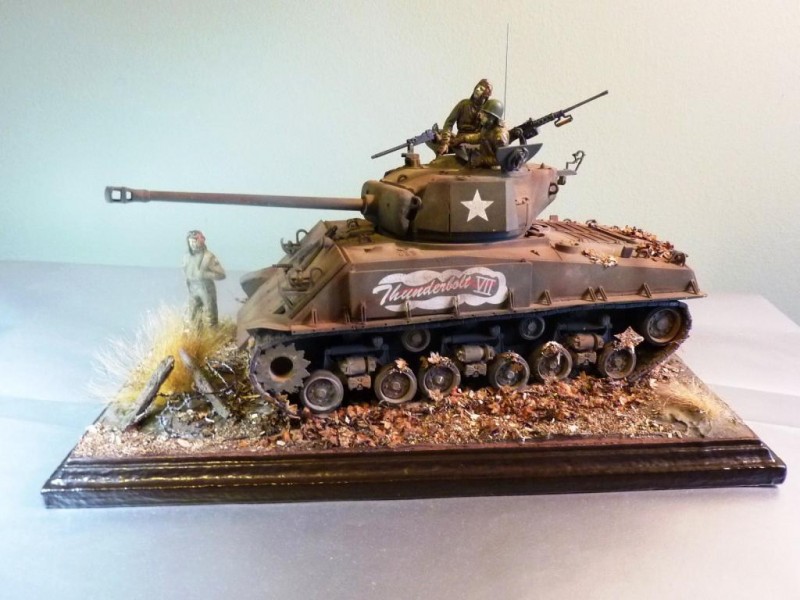
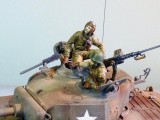
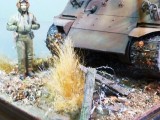
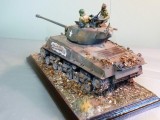
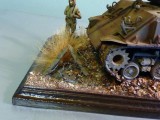
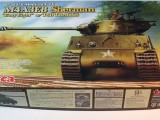

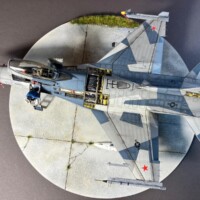
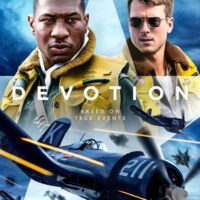
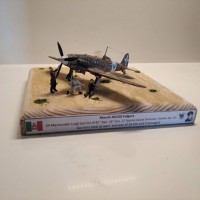
Great writing, Rob, but can you tell us anything about the model?
Apologies. I was so caught up in the old article I neglected the tech bits. It's the 1/35 Tasca M4A3E8 "Easy Eight" Sherman (I've added an image of the kit box.). It came on the market a year or so back.
Great looking vignette Rob. Your use of lighting & sharp close-ups let us see the details.
Well done.
Nice work, Rob...I like that. The figure painting is top-notch (as is the entire dio).
Great looking diorama and terrific story…I enjoyed both.
And Abrams went on to become Army Chief of Staff during Vietnam. He's memorialized as the namesake of the M-1 MBT.
Nice build and very informative back story.
Rob,
Excellent build and a tremendous story. I really like all you have done here.